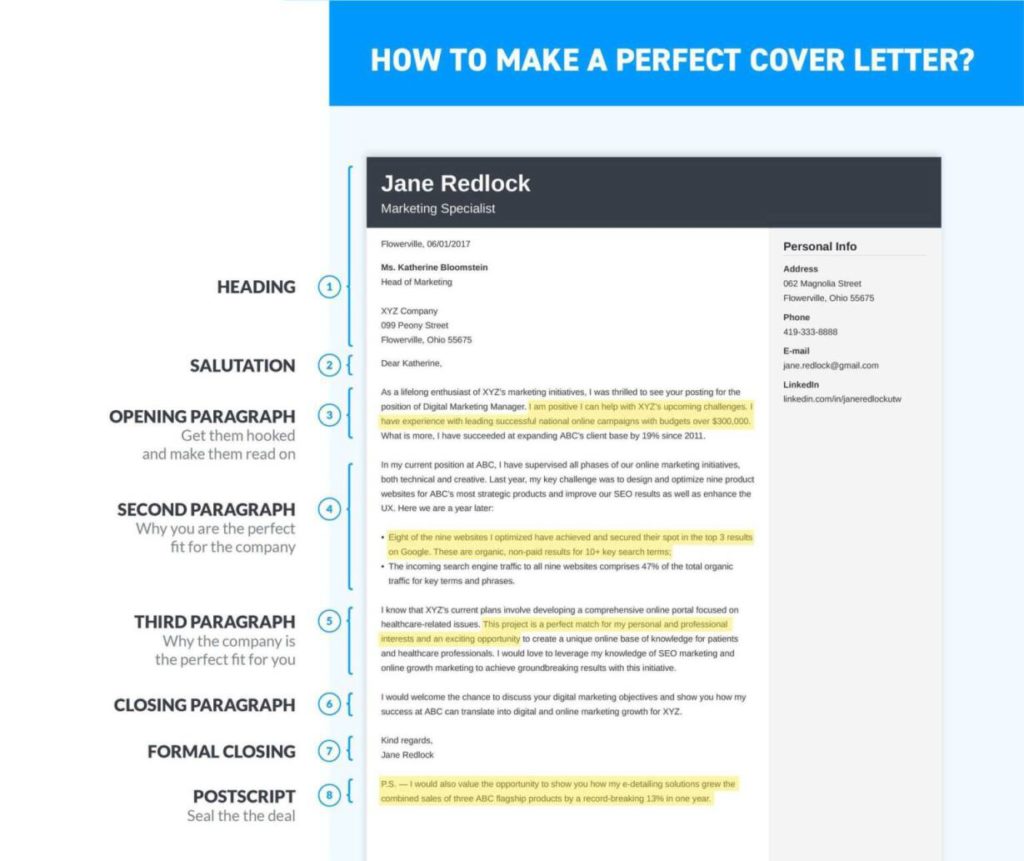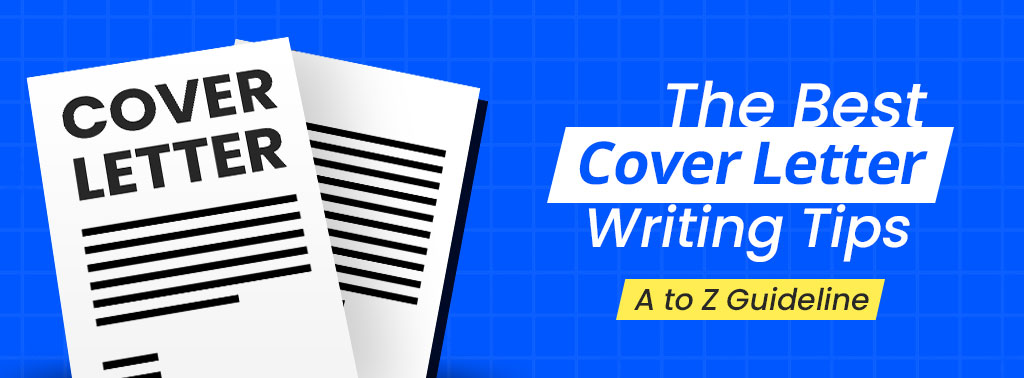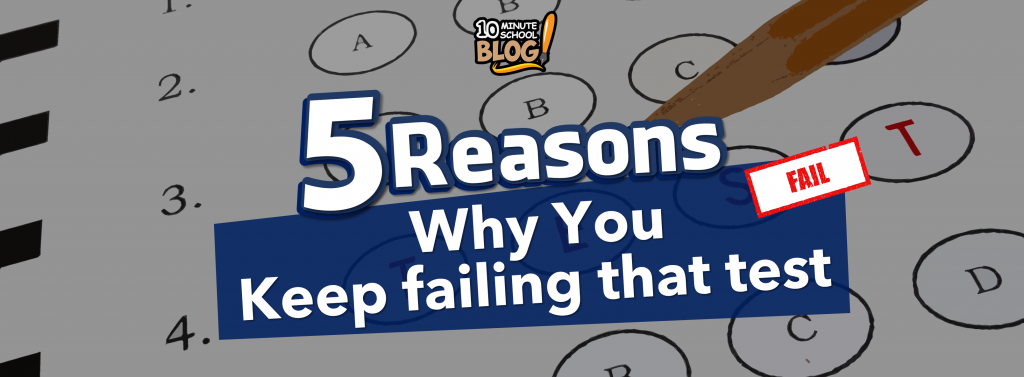A cover letter is just as important as your resume when it comes to your job application. It is an opportunity to briefly introduce yourself with the hiring manager, explain why you are interested in that job, and point out your unique expertise in that field of job. This blog will be an A to Z guideline for you to write a Cover Letter that will make the Hiring Manager say, “Wow!”
What is a Cover Letter?
A cover letter generally means a one-page document that is submitted with the resume when someone is applying for a job. It is designed to introduce yourself in a more personal way, expanding on relevant skills, and achievements, and highlighting a selection of your most prominent accomplishments.
Purpose of a Cover Letter
The main purpose of a cover letter is to introduce yourself to the hiring manager and to give an explanation for why you are interested in this job and why they should hire you. It is a spotlight on your skills and experience. It is an opportunity to go beyond your resume and display to the hiring manager why you are a nice candidate for that position.
A well-written cover letter allows you to:
- Stand out from other applicants
- Flaunt your passion for the job and the company
- Show that you did research and took the job seriously
- Prove you understand the challenges of the company
- Highlight your skills and experience that are most relevant to the job
- Reflect that your vision aligns with their goals
- Make a good first impression on the hiring manager, because your first impression may be your last impression
In short, a cover letter is your chance to promote yourself to the hiring manager and to show your personality and enthusiasm for the job. As it is an integral part of the job application, it should not be overlooked.
Microsoft Word
কোর্সটিতে যা যা পাচ্ছেন:
How to write a Cover Letter? – Step by Step
An ideal cover letter should be 2-4 paragraphs long within one page. Now there may be a question in your mind regarding what you should include in the letter. Here is a step-by-step guideline for writing a cover letter for a CV:
01. Contact Information in Header
A professional cover letter starts with a header. The header should not only just carry your contact information, but also that of the company to which you are applying. The header of your cover letter must include the following contact information:
- Full name
- Job title
- Phone number
- Email address
02. Address the Hiring Manager
Once you’re done with the header, it’s time to mention the Hiring Manager. You can address the hiring manager by name. For example: “Dear Katherine”. If you don’t know the hiring manager’s name, you can address the letter to “Dear Hiring Manager.”
List of Salutations
| Salutation | When to use |
| Dear Human Resources Manager | When you’re applying for a job at a large company and you don’t know the name of the hiring manager or recruiter. In this situation, you can also use “Dear Head of Human Resources” |
| Dear [Hiring Manager’s first and last name] | When you know the name of the hiring manager.
For example: “Dear Tasnuva Nadia” |
| Dear [Company name] Hiring Manager | When you don’t know the name of the hiring manager.
For example: “Dear 10 Minute School Hiring Manager” |
| Dear [Company name] Recruiter |
When you’re applying for a job through a recruiter. For example: “Dear 10 Minute School Recruiter” |
| To Whom It May Concern | When you don’t know the name of the hiring manager or recruiter and
you’re applying for a job at a small company. |

03. Introductory Paragraph
In the introductory paragraph, state the position you are applying for and why you are interested in it. Here you need to start in a way that attracts and holds the reader’s interest. You can also mention something specific about the company that you admire or are excited about.
Here are several proven strategies for starting the introductory paragraph of your cover letter for the job:
- Highlight your achievements.
- Display your passion and enthusiasm.
- Drop names of people in the company who inspired you.
04. Second Paragraph
The second paragraph is the main body of a cover letter for a job, where you must highlight the skills and experience that are most relevant to the job you are applying for. Be specific and provide examples of your accomplishments.
05. Third Paragraph
In the third paragraph, explain why you are a good fit for the company. What can you offer them? How will you contribute to their success? You can also mention your values and how they align with the company’s mission and values.
06. Closing Paragraph
End with a call to action. Tell the hiring manager what you would like to happen next, such as scheduling an interview. You can also thank them for their time and consideration.
07. Formal Closing Salutation
After you have finished the main points of your cover letter, the last thing that remains is to include a professional ending. In this closing salutation, you can simply write “Sincerely” and follow it with your full name.
Instead of writing “Sincerely” you can also use:
| Respectfully | With kind regards | Yours truly | Warm regards | Best wishes |
| Cordially | Best regards | Yours respectfully | High regards |
08. Postscript
Last but not least, conclude the letter for your CV with a postscript. All of the elements that are listed above are required in an ideal cover letter. However, there is one specific method you can use: the postscript. It is very important because it attracts the hiring manager’s attention and says, “You cannot miss this information.”
Microsoft Word
কোর্সটিতে যা যা পাচ্ছেন:
6 Different Types of Cover Letter
There are different types of Cover Letters because each type is tailored to a specific purpose. Here is a brief overview of the different types of Cover Letters:
1. Application
A cover letter used with a resume submission or with a job application is called an application cover letter. This is the most common type of cover letter. It is used to apply for a specific job opening. An application cover letter should highlight your skills and experience that are most relevant to the job you are applying for.
2. Prospecting
A prospecting Cover Letter for a job is used to inquire about job openings at a company that you are interested in working for, even if there are no current openings listed. A prospecting cover letter should explain why you are interested in working for the company and what you can offer them. The objective of a prospecting cover letter is to prospect for companies using a cover letter.
3. Networking
This type of letter is used to reach out to people in your professional network to ask for advice or job referrals. A networking cover letter should be brief and to the point. It should explain why you are reaching out to the person and what you are looking for.
4. Referral
A referral cover letter accommodates to identify yourself while also stating who referred you to the post. Referrals can be a valuable resource in the job market if they are reliable and have an enduring connection with the company you’re applying to. If you’re applying through a referral, including it in the letter may provide you an advantage by capturing the hiring manager’s attention.
5. Email
An Email Cover Letter is sent in an email. It is similar to a traditional cover letter. These letters are typically brief and incorporate more white space.
6. Academic
This is used to apply for academic positions, such as teaching or research positions. An academic cover letter should highlight your academic qualifications and research experience.
6 Most Important Tips and Tricks to write a Cover Letter for a job application
Cover Letter Tips #1 Know the basics
Before writing a cover letter for a job, make sure that you understand what an ideal letter looks like. In a nutshell, a cover letter is made up of the following sections:
- A header including your contact details
- Addressing the hiring manager
- The introductory paragraph, in which you begin with an attention grabber and lists your most notable accomplishments
- The second paragraph should describe why you are the best candidate for the job
- The third paragraph is where you explain why you’re a good fit for the company, its culture, and its ambitions
- The ending remarks
- Lastly, a postscript
Cover Letter Tips #2 A Strong Introduction
Start the cover letter with a strong introduction. In the opening paragraph mention the position you are applying for, and then briefly explain why you are interested in the job and why you are the best candidate for that post.

Cover Letter Tips #3 Address the hiring manager by name
According to the opinion of HR experts, people respond actively to reading their names in a cover letter for a job. So addressing the hiring manager by name can be an advantage for you. You can look for the hiring manager’s name by checking the job description or visiting the company’s LinkedIn page. It will show the hiring manager that you have researched for this position.
Cover Letter Tips #4 Customize your cover letter for the job
You might feel pressured to compose a single, unique cover letter and send it with your application for every job. Different positions have different requirements and responsibilities. If you can convince the hiring manager of your eligibility for one particular position rather than your overall professionalism, you have a better chance of getting hired. For this reason, a one-letter-fits-all strategy is ineffective. So, write a new cover letter for each application.
Tips #5 Follow the guidelines
Sometimes companies specify in the job description the format that must be followed. To avoid facing consequences early in the recruiting process, make sure that you comply with any format and content guidelines that may be provided. A requirement-focused cover letter indicates your ability to follow directions, which is an essential skill for most professions.
Cover Letter Tips #6 Highlight your unique skills and abilities
While the letter should highlight your abilities that are relevant to the position you are applying for, your letter should highlight all of your skills that are suitable for your chances of getting hired.
Sample
Let’s have a look at a sample format for the position of content writer in 10 Minute School:
. |
Frequently Asked Questions (FAQs) and Answers
After reading this blog, you may have various questions and concerns. In this section, we provide answers to frequently asked questions to help you navigate the job-seeking journey with confidence:
Q: What is a cover letter?
A formal letter written to a potential employer that explains why you are interested in a particular job and why you are qualified for it.
Q: What is the main purpose of writing a cover letter?
The main purpose of writing a cover letter is to convince a potential employer that you are a qualified candidate for the position you are applying for.
Q: How long should it be?
It should be one page long, single-spaced, with a 12-point font.
Q: What are the essentials of a cover letter?
- Header
- Addressing the Hiring Manager
- The introductory paragraph
- Ending remarks
- Postscript
Q: What are the common mistakes to avoid in cover letters?
- Not tailoring your cover letter to the specific job you are applying for
- Not providing specific examples of your work
- Using uncommon vocabulary
- Making grammatical or spelling errors
- Not proofreading carefully
Conclusion
Writing a cover letter is an important step in the job application process. It is your chance to introduce yourself to the hiring manager, it also explains why you are interested in the position and why you are the best candidate for the job. No matter what you choose to write, make sure that it is clear, concise, and professional. Your goal is to leave the hiring manager with a positive impression and to encourage them to contact you for an interview.
IELTS-এর ফ্রি ক্লাসে জয়েন করতে ক্লিক করুন এই লিঙ্কে: Book Your Free Class @ 10MS English Centre, Uttara
Explore our Free Courses:
- Study Abroad Complete Guideline
- English For Everyday
- Academic English Grammar
- English Grammar Fundamentals
- Pronunciation Mistakes
- Grammar Foundation Course
Check Out Our Academic Courses:
Check Out Our Skills Courses
- ঘরে বসে English Grammar
- Beginner’s English Bundle
- English Master Bundle
- ঘরে বসে Spoken English
- IELTS by Munzereen Shahid
Visit 10 Minute School’s website: www.10minuteschool.com





আপনার কমেন্ট লিখুন